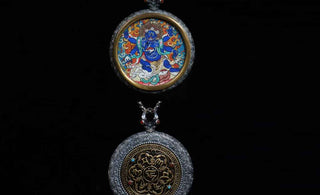
In the rich tapestry of Tibetan art, the revival of Thangka painting emerges as a captivating chapter, where tradition intertwines with contemporary expression. The term "Thangka" itself, derived from the Tibetan word "thang-ga," translates to "a thing that one unrolls." This ancient art form, dating back over a millennium, has undergone a renaissance, breathing new life into its sacred depictions.
The revival of Tibetan Thangka painting is a multifaceted phenomenon, driven by a confluence of factors that bridge the past and present. At its core, the revival reflects a profound appreciation for the spiritual and cultural heritage encapsulated in these intricate artworks. Artists and enthusiasts alike are drawn to the depth of symbolism, spiritual narratives, and the meticulous craftsmanship embedded in Thangkas.
One aspect of this revival is the resurgence of interest in traditional techniques. As contemporary artists delve into the historical methods of Thangka creation, they are not merely replicating the past but engaging in a dialogue with the ancient masters. The painstaking process of mineral pigment preparation, the intricacies of applying gold leaf, and the meditative strokes in rendering deity figures all contribute to a revival rooted in authenticity.
Beyond technique, the revival of Thangka painting intersects with a broader cultural resurgence. As Tibetan communities actively seek to preserve and promote their cultural identity, Thangka art becomes a poignant symbol of resilience.
An exemplary illustration of this commitment can be witnessed in the efforts of monastic institutions, local artists, and cultural enthusiasts who have come together to safeguard the heritage encapsulated in Thangkas.
Monasteries, often the custodians of Tibetan cultural traditions, have played a pivotal role in this endeavor. In the face of historical challenges and geopolitical shifts, monastic communities have recognized the power of Thangka art to encapsulate and transmit spiritual teachings, cultural narratives, and symbolic representations. Many monasteries have established dedicated spaces for Thangka painting, serving as ateliers where novice artists learn under the guidance of seasoned masters.
One notable example is the Drepung Monastery in Lhasa, where a concerted effort has been made to revive the ancient Thangka painting tradition. Monks, artists, and scholars collaborate to impart the intricate techniques and profound symbolism inherent in Thangkas to a new generation. This not only ensures the continuation of this sacred art form but also fosters a sense of pride and connection to Tibetan heritage among the younger monks.
Local artists within Tibetan communities are crucial agents in the cultural revitalization process. Recognizing the significance of Thangka art as a repository of spiritual wisdom and cultural identity, these artists often undergo rigorous training in traditional techniques. Their work goes beyond individual artistic expression; it becomes a collective effort to reclaim and reaffirm Tibetan cultural distinctiveness.
In regions like Amdo and Kham, artists are actively involved in Thangka painting workshops and collaborative projects. The Kangyur and Tengyur Thangka Project, for instance, brings together artists from diverse Tibetan regions to create Thangkas illustrating the teachings of the Kangyur and Tengyur, the canonical scriptures of Tibetan Buddhism. Through such initiatives, artists not only revive Thangka painting but also contribute to the broader preservation of Tibetan cultural and religious heritage.
Cultural enthusiasts, both within and outside Tibetan communities, also play a vital role. Non-profit organizations, cultural institutions, and individuals passionate about Tibetan heritage have initiated projects to support Thangka painters, organize exhibitions, and facilitate educational programs. These endeavors serve as bridges, connecting the resilience of Tibetan cultural identity with a global audience, fostering understanding, appreciation, and support.
The digital age has also played a pivotal role in the revival, acting as a bridge between tradition and a global audience. Online platforms showcase the mesmerizing details of Thangkas, connecting enthusiasts, scholars, and artists worldwide. This accessibility not only fosters appreciation but also invites diverse interpretations, breathing fresh vitality into an ancient form.
In exploring the revival of Tibetan Thangkas, it is essential to recognize the nuanced adaptations within contemporary expressions. While some artists adhere closely to traditional motifs and iconography, others push the boundaries, infusing Thangkas with modern sensibilities. This dynamic interplay between tradition and innovation underscores the adaptability and timelessness of Thangka art.
The revival extends beyond the canvas, seeping into educational initiatives, cultural festivals, and collaborative efforts. Workshops and training programs facilitate the transfer of Thangka painting skills to a new generation, ensuring the continuity of this sacred art form. Cultural festivals provide platforms for artists to showcase their creations, fostering a sense of community and celebration.
Conclusion
In conclusion, the Tibetan Thangka revival is a testament to the enduring resonance of spiritual and cultural traditions. As artists rekindle the flame of this ancient art, they simultaneously illuminate new pathways for its evolution. The revival is not a nostalgic glance backward; rather, it is a vibrant, forward-facing celebration of Tibetan heritage, inviting everyone to unroll the sacred narratives woven into the intricate fabric of Thangka paintings.

























